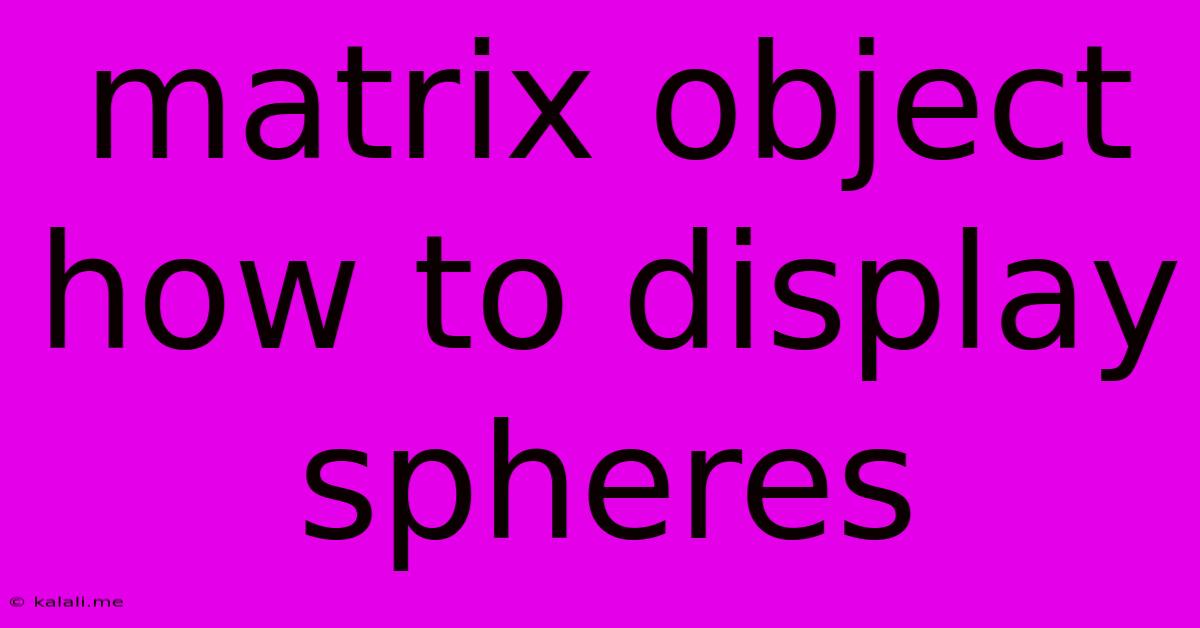Matrix Object How To Display Spheres
Kalali
Jun 08, 2025 · 3 min read

Table of Contents
Displaying Spheres in a Matrix Object: A Comprehensive Guide
This article provides a comprehensive guide on how to effectively display spheres within a matrix object, covering various programming languages and techniques. Understanding how to manipulate 3D objects within a matrix framework is crucial for creating dynamic and interactive visualizations in fields like game development, computer graphics, and scientific simulations. We'll explore the fundamental concepts and provide practical examples to help you achieve visually appealing results.
The core concept involves transforming the individual sphere's position within a three-dimensional space using matrix operations. This allows for precise control over the sphere's location, rotation, and scaling within the larger matrix structure. The process generally involves these steps:
1. Defining the Matrix Structure
First, we need to define the structure of the matrix. This could be a simple grid, a more complex lattice, or any other arrangement that suits your needs. Consider the following:
- Dimensions: How many rows and columns (and potentially layers for a 3D matrix) will your matrix have?
- Spacing: What will be the distance between the spheres in your matrix? Consistent spacing simplifies calculations.
- Data Structure: Choose a suitable data structure to represent the matrix. This could be a 2D or 3D array, a linked list, or a more sophisticated data structure depending on the complexity of your project.
2. Sphere Representation
Next, we need to represent each individual sphere. This typically involves defining its:
- Position: The (x, y, z) coordinates of the sphere's center within the overall 3D space. This will be calculated based on its location within the matrix and the spacing between spheres.
- Radius: The size of the sphere.
- Material/Texture: The visual properties of the sphere (color, reflectivity, etc.). This often involves using shaders or material libraries specific to your chosen graphics rendering engine.
3. Matrix Transformations
The magic happens here. Using matrix transformations, we position each sphere correctly within the matrix structure. Key matrix operations include:
- Translation: Moving the sphere to its designated position within the matrix.
- Scaling: Adjusting the size of the sphere (though this is often handled separately).
- Rotation: Rotating the sphere (often less crucial for a simple matrix display, but important for more complex scenarios).
These transformations are typically implemented using matrix multiplication. The individual sphere's transformation matrix is multiplied by the matrix representing the overall matrix structure's position and orientation in the scene.
4. Rendering the Spheres
Finally, we need to render the spheres using a suitable graphics library or engine. Popular options include:
- OpenGL: A widely-used, cross-platform graphics library.
- DirectX: A Microsoft-specific graphics API.
- WebGL: A JavaScript API for rendering interactive 2D and 3D graphics within a web browser.
- Game Engines (Unity, Unreal Engine): High-level engines that simplify the rendering process significantly.
The specific rendering techniques will depend on your chosen library or engine. However, the general principle is the same: each sphere's transformed position, radius, and material properties are passed to the rendering engine, which then draws the spheres onto the screen.
Example (Conceptual Python with NumPy):
This is a simplified conceptual example illustrating the core idea. Actual implementation would require a graphics library.
import numpy as np
# Matrix dimensions and spacing
rows, cols = 5, 10
spacing = 2
# Create the matrix of sphere positions
matrix = np.zeros((rows, cols, 3)) # 3 for x, y, z coordinates
for i in range(rows):
for j in range(cols):
matrix[i, j] = np.array([i * spacing, j * spacing, 0]) #Simple arrangement
# (Rendering code using a graphics library would go here. This would iterate through 'matrix' and render a sphere at each position)
This article provides a high-level overview. The specific implementation will depend heavily on your chosen tools and the complexity of your matrix structure. Remember to consult the documentation for your specific graphics library or game engine for detailed instructions on rendering 3D objects. Further exploration into topics like model-view-projection matrices and shader programming will enhance your ability to create even more sophisticated visualizations.
Latest Posts
Latest Posts
-
How Long Does It Take For Wheat To Germinate
Jun 08, 2025
-
Where Do I Recharge Fire Extinguisher
Jun 08, 2025
-
Failed To Start Docker Service Unit Docker Service Not Found
Jun 08, 2025
-
How To Draw A Quarter Rest
Jun 08, 2025
-
How Did Moses Know Aaron Was His Brother
Jun 08, 2025
Related Post
Thank you for visiting our website which covers about Matrix Object How To Display Spheres . We hope the information provided has been useful to you. Feel free to contact us if you have any questions or need further assistance. See you next time and don't miss to bookmark.